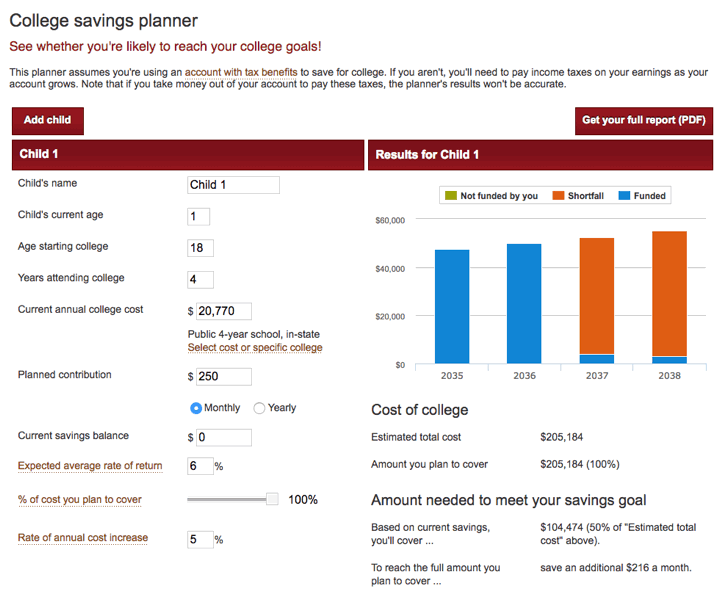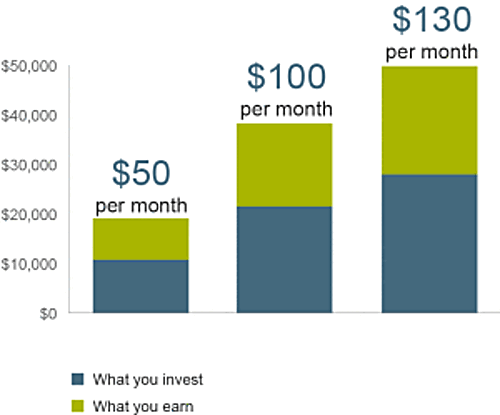 Thinking about 529 plans and like playing around with interactive calculators? This Vanguard tool helps you visualize how much you’ll need to save for college and how changing up a specific factor would affect your results. It adjusts for age, contributions, investment returns, tuition inflation, and even looks up the current cost of your favorite university. A formal report is spit out with lots of charts, just like a financial advisor might create for you. Here’s a sample screenshot:
Thinking about 529 plans and like playing around with interactive calculators? This Vanguard tool helps you visualize how much you’ll need to save for college and how changing up a specific factor would affect your results. It adjusts for age, contributions, investment returns, tuition inflation, and even looks up the current cost of your favorite university. A formal report is spit out with lots of charts, just like a financial advisor might create for you. Here’s a sample screenshot:

Tuition inflation is something that I think is hard to predict. However, I couldn’t think of anything better than accepting the default assumptions that investment return will only barely outpace tuition inflation.
If you’d rather have a quick, simple scenario, check out this Vanguard article on the power of automatic savings. If you put away $130 a month automatically every month for 18 years, at a 6% return you’d end up with $50,000. Putting away $50 a month reliably would get you to $20,000.

Nearly half of your final amount would be due to investment growth, which thanks to the 529 plan can be tax-free when used towards qualified educational expenses.
I’m still in the camp that retirement should be prioritized over college savings, but I definitely understand the parental instinct to provide the best educational opportunity possible. I’m still pondering the idea of targeting funding college with 1/3rd savings, 1/3rd spending from current income, and 1/3rd grants/scholarships/loans.
Finally, here is another set of handy Vanguard tools, a 529 Plan Interactive Comparison Map and Tax Deduction Calculator.
 The Best Credit Card Bonus Offers – 2025
The Best Credit Card Bonus Offers – 2025 Big List of Free Stocks from Brokerage Apps
Big List of Free Stocks from Brokerage Apps Best Interest Rates on Cash - 2025
Best Interest Rates on Cash - 2025 Free Credit Scores x 3 + Free Credit Monitoring
Free Credit Scores x 3 + Free Credit Monitoring Best No Fee 0% APR Balance Transfer Offers
Best No Fee 0% APR Balance Transfer Offers Little-Known Cellular Data Plans That Can Save Big Money
Little-Known Cellular Data Plans That Can Save Big Money How To Haggle Your Cable or Direct TV Bill
How To Haggle Your Cable or Direct TV Bill Big List of Free Consumer Data Reports (Credit, Rent, Work)
Big List of Free Consumer Data Reports (Credit, Rent, Work)
Calculator is broken – you can put in a planned contribution of $100k a month and it still says you are short
You need to change the slider “% of cost you plan to cover”. If you only want to cover 50%, that is the max and they will tell you how much you can lower your contribution by and still cover your desired amount.
Thanks for sharing this. I don’t know if you or others have ever tried to use Mint’s Goals for college savings but the Mint algorithm doesn’t account for earnings growth so it’s pretty much useless. Mint says I’m three years behind on my savings; Vanguard says I need to stop saving so darn much 🙂
I haven’t tried that tool, but I mostly use Mint for tracking all my various bank accounts these days and use Personal Capital to track investments. They haven’t really done much with their investing tools.
Hey Jonathan I’d be interested to see your take on how the many new free tuition programs for community colleges are affecting vehicles like 529s or if college savings strategies should be changed given you can always switch to a traditional brand name four year school for the last two years… with most employers never knowing the difference?